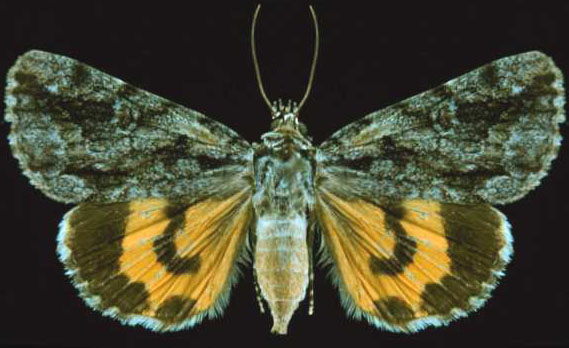Catocala grisatra
|
|
Updated as per personal communication from Rick Gillmore, May 7, 2007
|
Catocala grisatra
kah-TOCK-uh-lah mm
GRYE-sah-tra
Brower, 1936

The Grisatra Underwing,
by Harold J. Vermes.
This site has been created by
Bill Oehlke at oehlkew@islandtelecom.com
Comments, suggestions and/or additional information are welcomed by Bill.
| TAXONOMY:
Superfamily: Noctuoidea
Family: Noctuidae
Group: Noctuinina
Subfamily: Catocalinae
Genus: Catocala, Schrank, 1802
| |
MIDI MUSIC
"Moon River"
copyright C. Odenkirk
MIDI CITYON.OFF
<bgsound src="moon.mid" LOOP=FOREVER>
|
DISTRIBUTION:
The Catocala grisatra moth
(wingspan: 48-55mm) flies in the coastal plain in Bladen County, North Carolina,
south through Georgia to Florida. Specimens have also
been recorded in the southeastern
sandhills region of coastal North Carolina.
The forewings of this moth make it look like a miniature
ulalume.
The forewings are bluish grey with a darker anal dash and wide arc
from the reniform spot to the outer margin.
The median band of the
hindwing does not make a complete loop.
This species is uncommon and very local in its limited range.
FLIGHT TIMES AND PREFERRED FOOD PLANTS:
Catocala
grisatra flies as a single
generation with moths on the wing in May and June.
The Catocala grisatra caterpillar shows a preference for
hawthorns.
ECLOSION:
Adults eclose from pupae formed under leaf litter.
SCENTING AND MATING:
Catocala grisatra females
emit an airbourne pheromone and males use their antennae to track the
scent plume.
EGGS, CATERPILLARS, COCOONS AND PUPAE:
Eggs are deposited on tree bark in the fall and hatch the
following spring.
Larval Food Plants
Listed below are primary food plant(s) and alternate food plants. It is hoped that this alphabetical listing followed by the common
name of the foodplant will prove useful. The list is not exhaustive, although some species seem very host specific.
Experimenting with closely related foodplants is worthwhile.
Crataegus ......
|
Hawthorn (RG)
|
Return to Main Index
This page is brought to you by Bill Oehlke and the
WLSS. Pages are on space rented from Bizland. If you would like to become a "Patron of the Sphingidae/Catocala Sites",
contact Bill.
Please send sightings/images to Bill. I will do my best to respond to requests for identification help.
Enjoy one of nature's wonderments: Live Saturniidae (Giant Silkmoth) cocoons.

|

To show appreciation for this site, click on the flashing
butterfly to the left, a link
to many worldwide insect sites. |


